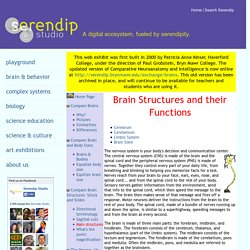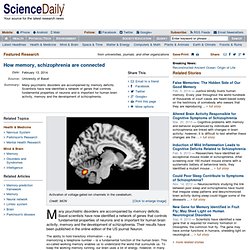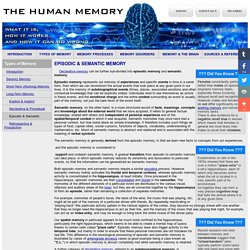

Development and evolution at Structural Brain Mapping Group. Brain Structures and Their Functions. The nervous system is your body's decision and communication center.

The central nervous system (CNS) is made of the brain and the spinal cord and the peripheral nervous system (PNS) is made of nerves. Together they control every part of your daily life, from breathing and blinking to helping you memorize facts for a test. Animal cognition. Animal cognition is the study of the mental capacities of animals.

It has developed out of comparative psychology, including the study of animal conditioning and learning, but has also been strongly influenced by research in ethology, behavioral ecology, and evolutionary psychology. The alternative name cognitive ethology is therefore sometimes used; much of what used to be considered under the title of animal intelligence is now thought of under this heading.[1] Research has examined animal cognition in mammals (especially primates, cetaceans, elephants, dogs, cats, horses,[2][3] raccoons and rodents), birds (including parrots, corvids and pigeons), reptiles (lizards and snakes), fish and invertebrates (including cephalopods, spiders and insects).[1] Historical background[edit] Animal cognition from anecdote to laboratory[edit] The behavioristic half-century[edit] Experiments reveal that crabs and lobsters feel pain. Lobsters and other crustaceans may feel pain.

Matthew Roy; Wikipedia Every year thousands of them are boiled or torn apart while they are still alive, and now there is strong evidence to suggest that crustaceans experience pain. That was the stark message delivered by Robert Elwood, an animal behaviour researcher at Queen’s University Belfast, to the Behaviour 2013 meeting in Newcastle, UK, today. Crustaceans — crabs, prawns, lobsters and other creatures — are generally not protected by animal-welfare laws, despite huge numbers of them being caught or farmed for human consumption. The exclusion has been based on the belief that these animals cannot experience pain — generally regarded as an ‘unpleasant feeling’ — and instead only have nociception, a reflex response to move away from a noxious stimulus.
Crabs shocked the second time the experiment was run were far more likely to choose the other shelter in the next trial, while crabs never left a non-shocking shelter.
LONI: Laboratory of Neuro Imaging. Pawan Sinha: How brains learn to see. Brain Facts and Figures. The Brains of the Animal Kingdom. A Breakthrough in Our Understanding of How Intelligence Evolves. Brain structures. MIT discovers the location of memories: Individual neurons. Update 12/2/15: We’ve now followed up on this story: The more we learn about memory, the weirder it gets.

The original continues below. MIT researchers have shown, for the first time ever, that memories are stored in specific brain cells. By triggering a small cluster of neurons, the researchers were able to force the subject to recall a specific memory. By removing these neurons, the subject would lose that memory. As you can imagine, the trick here is activating individual neurons, which are incredibly small and not really the kind of thing you can attach electrodes to.
Now, just to temper your excitement, we should note that MIT’s subjects in this case are mice — but it’s very, very likely that the human brain functions in the same way. How memory, schizophrenia are connected. Many psychiatric disorders are accompanied by memory deficits.

Basel scientists have now identified a network of genes that controls fundamental properties of neurons and is important for human brain activity, memory and the development of schizophrenia. Their results have been published in the online edition of the US journal Neuron. The ability to hold transitory information -- e.g. memorizing a telephone number -- is a fundamental function of the human brain. This so-called working memory enables us to understand the world that surrounds us.
To keep the working memory running, our brain uses a lot of energy, however, in many psychiatric disorders working memory is disturbed. Ion channels as key players In the current study, Angela Heck analyzed the genetic basis of working memory in over 2800 healthy participants across different age groups. Starting point for drug development. Episodic Memory and Semantic Memory - Types of Memory. Declarative memory can be further sub-divided into episodic memory and semantic memory.

Episodic memory represents our memory of experiences and specific events in time in a serial form, from which we can reconstruct the actual events that took place at any given point in our lives. It is the memory of autobiographical events (times, places, associated emotions and other contextual knowledge) that can be explicitly stated.